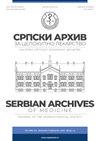小儿麻醉的历史
IF 0.2
4区 医学
Q4 MEDICINE, GENERAL & INTERNAL
引用次数: 0
摘要
儿科麻醉学的起源可以追溯到19世纪中叶,而它呢?这与一位乡村医生Crawford W. Long有关,他在1842年记录了第一例给一名8岁男孩使用乙醚麻醉的病例。现代小儿麻醉的发展被认为是在1930年开始的:这标志着两个发展时期。在第一阶段,我们开发了麻醉技术和配件,以适应不同儿童的年龄。第二阶段,将现代麻醉药物和监护引入日常临床实践,以更好地保护儿童体内的重要器官及其功能。1955年,儿童医院建立了第一个多学科儿科重症监护室。瑞典哥德堡医院。Branka Mitrovic博士被认为是我国儿科麻醉学的初学者,因为她于1955年在大学儿童医院创立了麻醉学和复苏部。小儿区域麻醉的历史是从什么时候开始的呢?在1884年可卡因发明之后,美国将其引入成人。塞尔维亚共和国卫生部于2018年批准了儿科麻醉学专业。小儿麻醉的发展是令人着迷的,因为它完全跟随小儿外科的发展。现代儿科麻醉学完全可以满足最复杂的手术干预的需要,以及对危重儿童的治疗,并显著有助于儿科外科患者治疗的更好结果。本文章由计算机程序翻译,如有差异,请以英文原文为准。
The history of pediatric anesthesia
The beginnings of pediatric anesthesiology go back to the center of nineteenth century, and it?s associated with a rural physician Crawford W. Long, MD, who in the 1842 recorded the first case of giving diethyl ether anesthesia to an eight-year-old boy. The start of development of contemporary pediatric anesthesia is considered to be in 1930: which marked two periods of progress. In the first period were developed anesthesia techniques and accessories adjusted to different children's ages. In the second period, modern anesthetic medications and supervision are introduced into everyday clinical practice in order to better protect vital organs and their functions in the child's body. In 1955 was established the first multidisciplinary pediatric intensive care unit at the Children?s Hospital of Goteburg in Sweden. Dr. Branka Mitrovic is considered to be the beginner of pediatric anesthesiology in our country, as she founded the Department of anesthesiology and reanimation in the University children's hospital in 1955. The history of pediatric regional anesthesia began after it?s introduction in adults, which occurred after the invention of cocaine in 1884. The Ministry of Health of the Republic of Serbia, in 2018, approved a specialisation in pediatric anesthesiology. The development of pediatric anesthesia is fascinating because it completely followed the development of pediatric surgery. Modern pediatric anesthesiology is entirely prepared to meet the needs of the most complex surgical interventions, as well as the treatment of critically ill children, and significantly contribute to the better outcomes of the treatment of pediatric surgical patients.
求助全文
通过发布文献求助,成功后即可免费获取论文全文。
去求助
来源期刊

Srpski arhiv za celokupno lekarstvo
MEDICINE, GENERAL & INTERNAL-
CiteScore
0.40
自引率
50.00%
发文量
104
审稿时长
4-8 weeks
期刊介绍:
Srpski Arhiv Za Celokupno Lekarstvo (Serbian Archives of Medicine) is the Journal of the Serbian Medical Society, founded in 1872, which publishes articles by the members of the Serbian Medical Society, subscribers, as well as members of other associations of medical and related fields. The Journal publishes: original articles, communications, case reports, review articles, current topics, articles of history of medicine, articles for practitioners, articles related to the language of medicine, articles on medical ethics (clinical ethics, publication ethics, regulatory standards in medicine), congress and scientific meeting reports, professional news, book reviews, texts for "In memory of...", i.e. In memoriam and Promemoria columns, as well as comments and letters to the Editorial Board.
All manuscripts under consideration in the Serbian Archives of Medicine may not be offered or be under consideration for publication elsewhere. Articles must not have been published elsewhere (in part or in full).
 求助内容:
求助内容: 应助结果提醒方式:
应助结果提醒方式:


